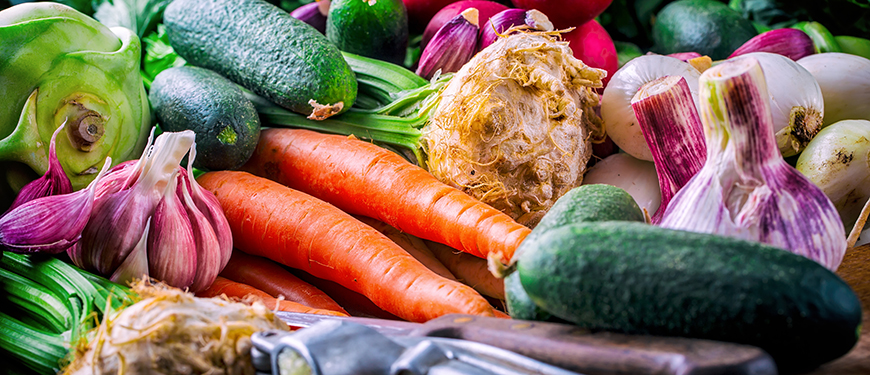Nutrition for All Ages

Being Healthy Starts with What You Eat
It’s common sense—you can’t expect your body to perform at it’s best if you fuel it with low-quality foods. Follow these easy nutritional tips to make sure you’re setting yourself up for a healthy future.
Nutrition Tips for Preschoolers
- The kinds of food your preschooler eats and drinks are important for his or her health. Fruits, vegetables, grains, protein and dairy provide the nutrients that their bodies need.
- Children’s appetites vary from day to day. Some days they may eat less and other days they may eat more. Make half of their plate fruits and vegetables.
- Allow your preschooler to enjoy a variety of whole or bite-sized fruits such as sliced apples, bananas, grapes or strawberries on a daily basis.
- Prepare red, orange and dark green vegetables like tomatoes, sweet potatoes, baby carrots, spinach and broccoli as part of your child’s meals and snacks.
- Offer dairy daily such as low-fat milk, yogurt and cheese to provide much needed calcium.
- Feed your preschooler 100% whole-grain cereals, breads and pasta as often as possible.
- Choose a variety of protein foods such as seafood, beans and small portions of meat like beef, chicken or turkey.
- Encourage water instead of fruit juice or sugary drinks. Even if you’re giving your child 100% juice, too much of it can add more calories than he or she needs.
- Offer a variety of healthy foods and let your child choose how much to eat. Children are more likely to enjoy a food when eating it is their own choice.
- Be patient with your child. Offer new foods often, and prepare them in different ways!
Nutrition Tips for Children
Children are constantly developing their food habits as they interact with the world. They learn from their surroundings and environment, so parents can help provide a healthy and supportive food-experience for their children by using the tips below.
Create a healthy balance. A healthy eating pattern includes a balance of foods from each food group. The main food groups include vegetables, fruits, grains, dairy, and protein. Try to include foods from each group at every meal.
Serve fruits and vegetables with every meal. These foods not only contain important vitamins and minerals, but they also contribute color and excitement to the plate.
Choose more whole fruit. The concentrations of calories and sugar in fruit juice add up quickly, so limit the amount of juice your children drink. Whole fruit has more fiber, an important nutrient for healthy bowel movements.
Make healthy foods fun. Encourage your kids to help you pick out fresh fruits and vegetables or involve them in the cooking process. They will often be more likely to try foods if they helped choose and prepare them.
Keep your house stocked with healthy choices. When kids get hungry and look for snacks, have good options on hand such as low-fat string cheese, vegetables and dip, fresh fruit, whole-grain crackers with peanut butter, etc.
Lead by example. When you make healthy selections and choices, your child is more likely to. Promote healthy foods and talk about them positively. Don’t make vegetables the bad guy!
Select whole-grain options. Whole grains have more fiber and nutrients than refined or “white” grains. Look for the words “whole grain” on the label of items like breads, pastas, rice, and cereals.
Choose a variety of lean protein foods. Select lean meats like chicken, turkey, fish, or lean cuts of beef. Expand the family’s taste buds and try some vegetarian options with beans, peas, or tofu.
Make healthier beverage choices. Choose water, unsweetened tea, or low-fat milk instead of sugary beverages that lack nutritional value.
Support strong, healthy bones with calcium. Get calcium from dairy foods or calcium-fortified non-dairy foods. You can also find small amounts in foods such as beans, spinach, and broccoli.
Select low-fat or fat-free dairy options. Use skim or 1% milk and reduced-fat cheeses and yogurts.
Create a relaxed atmosphere for meal time. Instead of gathering around the TV, gather around the table to talk and eat together. Let kids take their time when eating, and encourage them to listen to their own feelings of hunger and fullness to decide how much to eat.
Be patient with your child. Learning to enjoy new foods takes time, so keep offering new foods and flavors often. Try to avoid using foods as punishments or rewards.
Nutrition Tips for Teens
As children enter the teenage years, they begin to exercise more control over their choices and will want to make decisions for themselves. Support your teen’s desire for independence while continuing to keep your home stocked with healthy foods and options for them to choose from.
Support a healthy balance. A healthy eating pattern includes a balance of foods from each food group. The main food groups include vegetables, fruits, grains, dairy, and protein. Try to include foods from each group at every meal.
Encourage your teen to make time for breakfast. Consistently eating breakfast is associated with better school performance. Try foods like oatmeal with fresh fruit and almonds, whole-grain cereal with low-fat milk, or whole-wheat toast with peanut butter.
Help your teen fill up on fruits and vegetables. Many teens do not meet the recommendations for daily fruit and vegetable intake. Keep convenient and accessible fruits and veggies around the house to encourage consumption.
Select whole-grain options. Whole grains have more fiber and nutrients than refined or “white” grains. Look for the words “whole grain” on the label of items like breads, pastas, rice, and cereals.
Support strong, healthy bones with calcium. Get calcium from low-fat milks, yogurts, and cheeses or calcium-fortified non-dairy milks. You can also find small amounts in foods such as beans, spinach, and broccoli.
Choose a variety of lean protein foods. Select lean meats like chicken, turkey, fish, or lean cuts of beef. Experiment and try some vegetarian options like beans, peas, or tofu.
Provide healthier beverage choices. Choose water, unsweetened tea, or low-fat milk instead of sugary beverages that lack nutritional value.
Make time for home-cooked meals with the family. Even if your teen may be busy with school and social activities, make the effort to provide nutritious meals and snacks whenever possible.
Lead by example. When you make healthy selections and choices, your teen is more likely to. Avoid trying to force your teen to eat particular foods, as this may lead to resistance or rebellion.
Nutrition Tips for Adults
Following a healthy eating pattern is important throughout our entire life. All the food choices we make add up and contribute to our overall health and wellness. Use these tips to make small, gradual changes over time. Try to pick a few from the list that you feel you could apply to your diet and go from there. If you don’t succeed with a goal, pick another and try again!
Find a healthy balance. A healthy eating pattern includes a balance of foods from each food group. The main food groups include vegetables, fruits, grains, dairy, and protein.
Vary your veggies. Try enjoying them fresh, steamed, baked, or grilled. Different vegetables provide different nutrients, so mix it up and have fun experimenting with new kinds.
Focus on whole fruits or 100% fruit juice. You can enjoy fruit as a healthy snack or dessert when you are craving something sweet. Watch your juice intake, as the calories can add up quickly.
Select whole-grain options. Whole grains have more fiber and nutrients than refined or “white” grains. Look for the words “whole grain” on the label of items like breads, pastas, rice, and cereals.
Choose low-fat or fat-free dairy foods. Dairy is great source of calcium, an important nutrient for bone health that can help prevent bone issues as we age. If you cannot eat dairy foods, try non-dairy alternatives that are calcium-fortified like soy milk or almond milk.
Choose a variety of lean protein foods. Select lean meats like chicken, turkey, fish, or lean cuts of beef. Expand your taste buds and try some vegetarian options with beans, peas, or tofu.
Limit foods with added sugars. Added sugars are found in things like sodas, sweet teas, candies, and dessert foods. These foods do not provide many nutritional benefits, but add a lot of calories and may contribute to weight gain.
Make healthier beverage choices. Choose water, unsweetened tea, or low-fat milk instead of sugary beverages that lack nutritional value.
Limit foods with saturated fats. Saturated fats are found in items like red meats, full-fat dairy, butter, snack cakes, and fried foods. Try healthier, unsaturated fats from foods like fish, nuts, avocados, and vegetable oils (such as olive or canola oil).
Experiment with salt-free seasonings to help cut back on sodium. New spices and herbs can add a variety of exciting flavors to keep your meals fresh. Try garlic, chili powder, cinnamon, cumin, basil, red pepper flakes, oregano, paprika, onion powder, and others.
Limit alcohol consumption. If consuming alcohol is approved by your doctor, limit to no more than one drink per day for women and no more than two drinks per day for men. Alcohol adds empty calories to our diet and can contribute to other health risks.
Nutrition Tips for Diabetes Management
Balancing Carbohydrates
Carbohydrates (carbs) are the main nutrient that affects your blood sugar levels. They are an important source of energy, but eating too many carbs can lead to high blood sugar. Most people should aim for 45-60 grams of carbs per meal, but your needs may vary.
Choose Healthy Sources of Carbs
Select these healthier carbohydrate foods when planning a meal or snack:
- Whole fruits without added sugars
- Whole-grain breads, pastas, rice and cereal
- Starchy vegetables like corn, peas, potatoes, sweet potatoes and a variety of beans
- Low-fat or fat-free dairy products
Limit Less-Healthy Carbs
Limit your selection of less-healthy carbohydrate foods like candies, cookies and sweets and avoid sugary drinks like soda, energy drinks and sweet tea.
Enjoy More Non-Starchy Vegetables
Non-starchy vegetables are low in carbs, but high in vitamins and minerals important for health. They provide excellent nutritional benefits and will not affect blood sugar as much as other foods. For each meal, try to fill up half of your plate with non-starchy vegetables like:
- Cauliflower
- Broccoli
- Tomatoes
- Spinach
- Cabbage
- Cucumbers
- Mushrooms
- Okra
- And many more!
Ask your provider for a consult with a registered dietitian. A registered dietitian can help you set and achieve personalized nutrition goals. Don’t let diabetes control you.
We can provide a variety or services to assist in diabetes and high blood pressure management, including dietary counseling, screenings, bloodwork and more. Learn more about our services by visiting our diabetes services page.
Healthy Recipes and Cookbooks
Looking for fun and healthy ways to spice up your diet? Check out these free cookbooks and resources. For questions about healthy eating or help finding more recipes, ask your Health Department about scheduling an appointment with a Registered Dietitian.
Kids and Families
Eating Healthy on a Budget
Heart Health
Make an Appointment for Nutritional Counseling:
Call your nearest health department to ask questions or make an appointment!
Learn about our related health services:


 Contact Us
Contact Us Locations
Locations Job Openings at North Central Health District
Job Openings at North Central Health District Internships
Internships Board of Health
Board of Health Cost and Insurance
Cost and Insurance Privacy Policy
Privacy Policy Teens & Adults
Teens & Adults For Children
For Children Other Programs
Other Programs County Environmental Health Offices
County Environmental Health Offices Chemical Hazards
Chemical Hazards Tourist Accommodations
Tourist Accommodations Food Service
Food Service Rabies Control
Rabies Control Lead Poisoning Prevention
Lead Poisoning Prevention Body Art
Body Art Land Use
Land Use Swimming Pool Program
Swimming Pool Program Water Testing for Private Wells
Water Testing for Private Wells Environmental Health Complaints
Environmental Health Complaints Georgia Food Recall Alerts
Georgia Food Recall Alerts Personal & Family Preparedness
Personal & Family Preparedness Emergency Preparedness for Functional & Access Needs
Emergency Preparedness for Functional & Access Needs Severe Weather Preparedness
Severe Weather Preparedness Emergency Preparedness Training
Emergency Preparedness Training Medical Reserve Corps
Medical Reserve Corps Regional Healthcare Coalitions
Regional Healthcare Coalitions Strategic National Stockpile/Medical Countermeasures
Strategic National Stockpile/Medical Countermeasures

